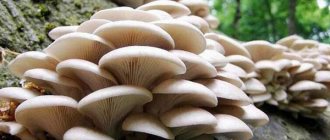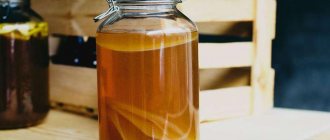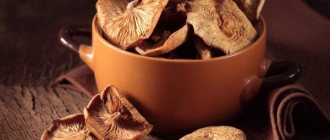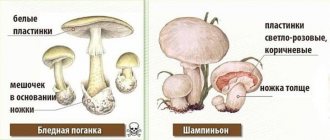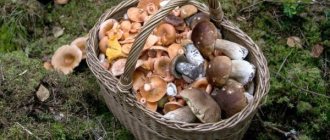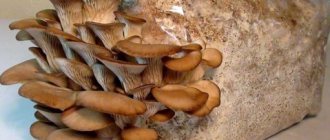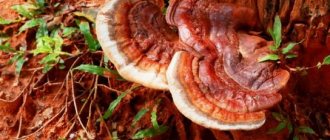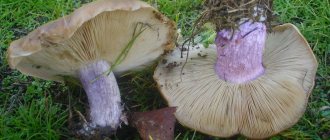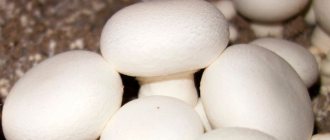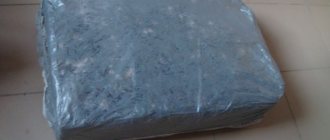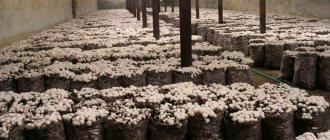Description and features of the mushroom
Based on its etymology, the yellow-skinned champignon is classified as a particularly dangerous toxic mushroom, as it is very similar to its edible relatives. Therefore, inexperienced mushroom pickers most often collect it, resulting in poisoning.
To prevent this from happening, you need to know what pecheritsa looks like:
- Hat. Its diameter varies from 5 to 15 cm, it is distinguished by its bell-shaped shape at a young age and spread-rounded at a more mature age. The color of the cap is light yellow interspersed with a brown tint. If you press on the surface, the mushroom acquires a pronounced yellow color. The skin is always dry and smooth. Over time, cracks form at the edges.
- Leg. Height - 6-15 cm, diameter - 1.8-3 cm. Characterized by a regular shape with a slight thickening at the base. Under the cap there is a wide double-layer ring. The inside is soft and hollow, the color is whitish.
- Pulp. At the beginning, the legs are yellow, but as they rise up (to the top of the cap) they become brownish-light, and at the point of swelling - orange.
- Hymenophore. The young fruit body is distinguished by white or pinkish thin plates, the older one is brown, sometimes with a grayish tint. Spore powder is chocolate.
- Aroma. During heat treatment, a phenolic odor appears (a very unpleasant pharmaceutical, inky odor). In its raw state, barely perceptible.
Proper storage
Of course, you can store champignons in the refrigerator. However, only if you are going to cook them in the near future. For long-term storage, they must be preserved and dried.
You may want to only eat fresh mushrooms. To do this, you can boil them for a few minutes, then freeze them and add them to the desired dishes as needed.
Long-term storage of store-bought champignons is also possible. To do this, they must lie on the bottom shelf of the refrigerator in an airtight package. If you buy mushrooms in reserve, you need to store them in the freezer. You can cut them into thin slices and put them into portioned bags for storage and then into the freezer.
You should not defrost such a product, as this will spoil the taste of the dish. If you want to cook something, you need to put frozen mushrooms in a frying pan and fry them until cooked. Only after this can you add them to the dish.
Fruiting time and distribution
The yellow-skinned champignon prefers deciduous or mixed forests with a lot of vegetation. Grows in parks and garden plots. The mushroom is widespread in Europe, North America, Australia, Russia and other countries (in recent decades it has been found throughout the world).
It especially loves warm weather and high humidity, so development is activated during rains. It grows in large groups, forming a “witch’s circle”.
The fruiting period occurs in summer and autumn. The yellow-skinned champignon can be found from the end of May to the end of September.
Taxonomic history
The official description and name of Agaricus xanthodermus in 1876 was given by the French botanist Léon Gaston Genevier, and published in the Bulletin of the French Botanical Society. Genevier described Agaricus mushrooms and tried to clarify the differences between them. He proposed a detailed reclassification into 5 species, including the yellow-skinned champignon. Until this time, these yellow-colored mushrooms were considered simply varieties of other edible species: A. arvensis, A. edulis and A. silvicola.
Similar species
The yellow-skinned champignon has many doubles. It is most often confused with the following edible mushrooms:
- Common champignon. Latin name Agaricus campestris. The cap is white, with a diameter of 10 to 15 cm, flat-rounded, and then spread out, in shape. The center is convex. The leg is 1–2 cm in diameter, up to 9 cm long. Like the cap, it is white. The flesh is the same shade, but turns red when broken. At a young age, the plates are white, then they become pink, then dark brown with a purple tint.
- Field champignon. Latin name Agaricus arvensis. The cap is initially bell-shaped, then spread out, white at first and yellowish at a more mature age. Its diameter varies from 5 to 20 and even 30 cm. The leg is 6–10 cm long and cylindrical in shape. The flesh is white, and when pressed, like the yellow-skinned one, it turns yellow (but not instantly). The plates are initially white, then acquire a light pink, mustard, burgundy or black color.
- Double-ringed champignon. Latin name Agaricus bitorquis. Hat - diameter from 3 to 15 cm, color snow-white or off-white. The stem has a diameter of 2 to 4 cm, a height of 3 to 10 cm. The pulp is white; when broken, the color almost does not change, but may show a slightly pinkish tint. The plates are pink.
All these mushrooms have a pleasant mushroom aroma.
Widespread Misconceptions
- Uninformed mushroom pickers believe that there are special techniques to distinguish edible mushrooms from poisonous ones. Here are some of these prejudices.
- A silver spoon or onion darkens in a decoction of poisonous mushrooms. In fact, darkening occurs under the influence of enzymes, in particular tyrosinade, and it is found in both some edible and poisonous mushrooms. The pale toadstool does not darken silver.
- Insects and snails do not eat poisonous mushrooms. In fact, they eat both edible and poisonous mushrooms. For example, a good chanterelle mushroom is rarely wormy, and the satanic mushroom, which is quite poisonous in its raw form, is often eaten by insects.
- Poisonous mushrooms must have an unpleasant odor. In fact, the pale toadstool has a good smell, some poisonous talkers and galerinas smell pleasantly of flour, and edible milkweed in adulthood and some russula emit the smell of a rusty herring.
- Only mushrooms are poisonous when mature. In fact, white and pale toadstool and other deadly mushrooms are poisonous at any stage of development.
- Only the skin of the mushrooms is poisonous. In fact, even the spores of the toadstool, for example, are poisonous.
So, you need to understand: there are no simple and universal ways to recognize mushrooms. Over the course of thousands of years, through trial and error, at the cost of thousands of lives, humanity has learned which mushrooms are poisonous. Using this experience, summarized in mushroom reference books, seeking advice from experienced mushroom pickers, strictly following the rules for collecting and processing mushrooms, you will protect yourself and your loved ones from troubles or tragedy. You need to firmly understand: it is better not to take several good mushrooms if you have doubts about the definition, than to put one deadly poisonous one in the basket.
Based on the book by Irina Alexandrovna Ukhanova “Mushrooms of Russia”
How to distinguish edible look-alikes from poisonous mushrooms?
Based on statistical data, in almost 50 cases out of 100, poisoning occurs with yellow-skinned champignons. The reason is the great similarity with edible representatives, and mushroom pickers’ ignorance of the nuances of how toadstools differ.
How to identify a toxic mushroom:
- the main indicator of toxicity is the formation of a yellow tint when cutting, breaking, or simply rubbing the surface (edible mushrooms have a different tint, and if there is a tendency to turn yellow, it appears no earlier than after 2–4 minutes);
- the smell is always unpleasant and reminiscent of a hospital one;
- The color of the leg when cut is bright yellow or orange in young specimens, brown in old specimens.
How to identify yellow-skinned champignon, watch our video:
Medicinal properties
The yellow-skinned champignon is poisonous and should not be eaten under any circumstances. Despite this, pecheritsa has found application in traditional official and folk medicine. This is due to the unique chemical composition of false pecheritsa. It includes:
- antibiotic penicillium (the substance penicillin is made from it);
- antibacterial element campestrin;
- antibiotic psalliotin;
- agaricin;
- calvacic acid.
These components are used in medicines for the treatment of typhoid, paratyphoid, consumption, cancer, staphylococcal, Salmanella and other infections by fungi and bacteria. Products based on yellow-skinned champignon are used for purulent wounds, etc.
Growing
Like any champignon, the yellow-skinned species can also be grown at home. Some farmers do this successfully, having previously entered into an agreement with pharmaceutical companies to market their products.
But there are other reasons for breeding false pecheritsa:
- help improve the absorption of nutrients by trees, as they enter into symbiosis with them;
- cleaning soil from technogenic waste;
- absorption of radio emissions, pesticides;
- accelerating the growth of agricultural crops;
- increasing productivity in the garden.
To achieve these results, many gardeners grow yellow-skinned champignon directly in the beds or in the garden. There are no other purposes for growing poisonous mushrooms.
When planting in open ground, it is advisable to fertilize it with manure, since mushrooms do not grow in infertile soil. In other situations, the basement is used. It must have concrete walls, ceilings and floors. A mandatory requirement is a ventilation system.
The space in the basement is zoned into 2 parts:
- for the incubation period, that is, growing mycelium, the temperature is + 22°C;
- for forcing mushrooms - the temperature is about + 16°C.
To obtain spores, just go to the forest, collect several false champignons and place them in a nutrient medium. There are several options:
- in 600 ml of water, add 400 g of carrot extract, 15 g of agar-agar, boil for 25–30 minutes, strain;
- mix 7 tsp in 1 liter of water. agar-agar, 1.5 tbsp. l. oat flour, bring to a boil, mix thoroughly, strain.
Next, proceed as follows:
- Treat your hands and tweezers with antiseptic, sterilize glass jars and lids.
- Break the mushroom and pinch off some biomaterial from it.
- Place the piece in a jar with nutrient medium and close the lid.
- Leave until mycelium (white threads) forms. This takes from 10 to 15 days.
Now prepare the growing substrate. It consists of the following components:
- manure (preferably horse) - 200 kg;
- straw - 5 kg;
- urea - 0.5 kg;
- chalk - 0.75 kg;
- plaster or alabaster - 1.8 kg;
- fertilizers - Superphosphate (0.5 kg), ammonium sulfate (0.8 kg).
Cooking instructions:
- Soak the straw in warm water and leave for 24 hours.
- Mix it with manure, adding warm water. Keep for 96 hours.
- Add urea and fertilizers. Leave for 72 hours.
- Connect with plaster.
- Place the prepared and thoroughly mixed mixture on the floor covered with plastic film.
- Leave for 96 hours.
- Make grooves like a chessboard. The distance between them is 20–25 cm, the depth is 2–3 cm.
Place the mycelium in the grooves. Make sure the humidity level is at least 90-95%.
Contraindications and signs of poisoning, first aid
The yellow-skinned champignon is contraindicated for ingestion by absolutely all people (the mushroom is considered highly toxic). It cannot be eaten not only raw, but also after heat treatment. If the mushroom enters the stomach, intoxication of the body occurs. It manifests itself with the following symptoms:
- nausea and vomiting;
- pain in the abdominal area;
- increased sweating;
- dizziness;
- diarrhea;
- fainting state.
The nature of the poisoning belongs to group No. 1, since the irritating effect on the digestive system appears 15 (maximum 20) minutes after the fungus enters the body. The toxin is eliminated within 3–4 days. Poisoning is not fatal.
Human death is possible if you eat a large amount of pecheritsa.
The first thing to do in case of intoxication is to call an ambulance. While waiting for a doctor, you can relieve the condition yourself:
- drink pure still water (1.5–2 l) or soda solution (1 tsp per 200 ml of water), which will cause vomiting;
- to induce a gag reflex, press your finger on the root of the tongue;
- take any enterosorbent - Enterosgel, activated carbon, Polysorb;
- take a lying position;
- put a heating pad on your legs and stomach.
Picking mushrooms is not possible without checking them for edibility. We must not forget that the yellow-skinned champignon cannot be distinguished from its edible relative by appearance. You will need to study the rules of identification and use them directly in the forest so that good pecherits do not come into contact with poisonous ones in the same basket.
0
0
Copy link
When do champignons appear?
Champignons prefer moderate rains. Their body is close to the surface of the earth. Therefore, the mycelium moisturizes very quickly and within a few days young mushrooms appear. Can be collected 3-4 days after rain. The lifespan of the mushroom is short, so after 2 weeks you should not fill the basket with old specimens.
They do not appear simultaneously in different regions:
- In the southern regions - in early spring - in April, as soon as the sun begins to get hot. A prerequisite for this is humidity and warmth.
- In the northern regions - in July-August. Incredibly, field champignon can be found even during frosts!
Their peculiarity is that they grow every 2 weeks. There will always be a harvest!
Of course, it’s easier to buy champignons in the store, because they are sold throughout the year. But nothing can replace the “silent hunt”!
